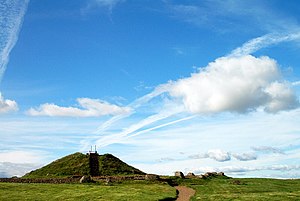Template:FP-Cairnpapple Hill: Difference between revisions
Jump to navigation
Jump to search
No edit summary |
No edit summary |
||
| Line 6: | Line 6: | ||
In a county not known for its hills, Cairnpapple Hill rises to a summit at 1,024 feet above sea level, which makes it the highest point in West Lothian, though the nextdoor hill, The Knock, is just a foot short of it. | In a county not known for its hills, Cairnpapple Hill rises to a summit at 1,024 feet above sea level, which makes it the highest point in West Lothian, though the nextdoor hill, The Knock, is just a foot short of it. | ||
The hill is best known for its ancient burial cairns and the signs found there of ritual use over thousands of years: it was apparently used and re-used as a major ritual site over about 4,000 years, and in its day would have been comparable to better known sites like the Standing Stones of Stenness.}}<noinclude> | The hill is best known for its ancient burial cairns and the signs found there of ritual use over thousands of years: it was apparently used and re-used as a major ritual site over about 4,000 years, and in its day would have been comparable to better known sites like the Standing Stones of Stenness.}}<noinclude>{{FP data}} | ||
Latest revision as of 11:39, 4 May 2021
 |
Cairnpapple HillCairnpapple Hill, rising behind Bathgate, is a hill in West Lothian with a dominating position in the Central Lowlands giving views from the summit to both coasts, on the Forth and the Firth of Clyde. In a county not known for its hills, Cairnpapple Hill rises to a summit at 1,024 feet above sea level, which makes it the highest point in West Lothian, though the nextdoor hill, The Knock, is just a foot short of it. The hill is best known for its ancient burial cairns and the signs found there of ritual use over thousands of years: it was apparently used and re-used as a major ritual site over about 4,000 years, and in its day would have been comparable to better known sites like the Standing Stones of Stenness. (Read more) |